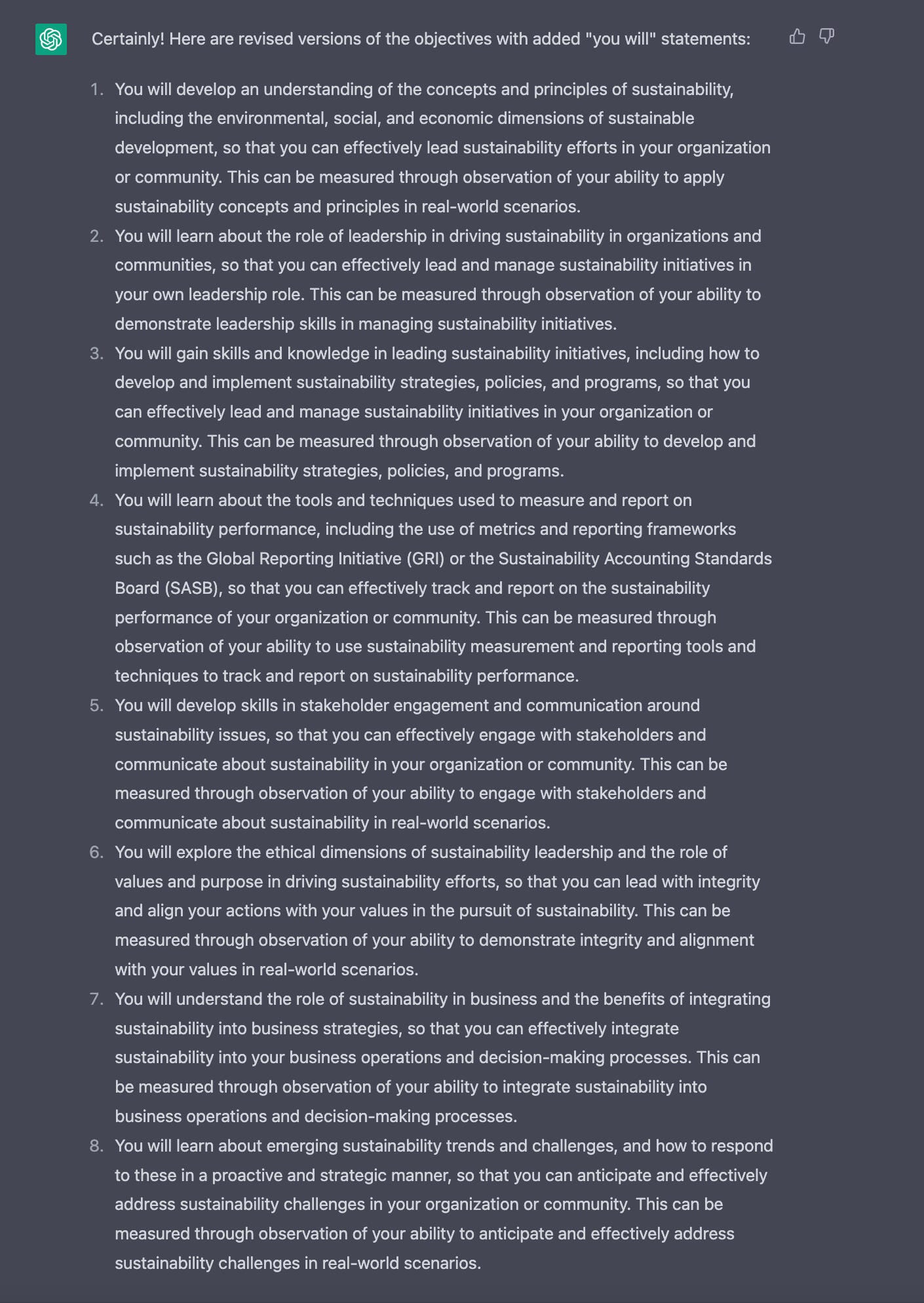Writing Learning Objectives in a Post-AI World
A great example of the power of human + machine?
Learning objectives play a critical part in dictating the success or failure of a learning experience. How well a learning objective is written is a powerful predictor of the overall success [impact] of a learning experience.
This week, I’m going to summarise what the research tells us about the formula for optimised objectives, and answer the question that I asked myself at the start of this week: what might the process of objective writing look like for Learning Designer 3.0?
The Science of Great Objectives
Research shows that learning objectives are optimised for learner motivation & mastery when they are:
Learner-Centered
Objectives address the learner directly, and map learning experiences to learners’ personal and professional goals.
Objectives should be constructed as statements of “what the learner will be know and be able to do as a result of some learning experience, as well as including some comment on the why.” (Mager, 1997).
Focused on the Why
Objectives include "so that you can" statements which help learners to understand the value of the experience, and increase their motivation
Objectives are more effective when they describe applicable knowledge & skill as they might be used in a professional setting, rather than simply stating a contextless task.
For example, saying “You will be able to explain neuroanatomical structures and their functions to a client, so that you can increase your influence in the workplace” is preferable to “you will be able to define neuroanatomical structures and their functions.”
Framing objectives in this way exposes the relevance and value of learning to students, increasing internalised motivation (Merriam, 2018).
Measurable
It should be possible to measure how well the objective is met, and the means of measurement should be made clear to the learner
Objectives should help students to understand the knowledge and skills they must acquire. They should also focus students on what success looks like in the pursuit of the objective (Wiggins, 1990).
How Good is AI at Writing Learning Objectives?
As part of my research into the impact that AI might have on our roles as learning designers (see my recent post on Learning Design 3.0) I spent some time this week exploring the question: what might the process of objective writing look like in the post AI world?
Here’s how it went.
Step 1: I asked ChatGPT to write me some objectives for a course on sustainability leadership for leaders with no experience of sustainability - the results were pretty impressive:
Step 2: In order to optimise the objectives for motivation, I asked ChatGPT to add "so that you can" statements to the end of each of my objectives.
The result? The AI immediately added these statements, making it clear to the learner what the real world impact of objective would be, thus increasing motivation.
In the process, it also added "you" language" which made the objectives more learner-centred:
Step 3: To optimise the objectives even more, I asked ChatGPT to make them more measurable. Here's what it came up with:
Step 4: The objectives were taking shape, but they were also getting a bit confusing (written in third person + first person). So, I asked ChatGPT to turn them into learner-facing "you will" statements:
Step 5: I wanted to ensure adequate stretch, so I asked AI to only use Bloom’s higher order verbs. It got straight on to it:
Step 6: So I can communicate to my learners how their performance will be measured, I asked ChatGPT to rustle me up an assessment rubric. It created four levels of mastery for each objective, e.g.
Bingo! Through asking the right questions, I was able to create an above-average set of learning objectives in ~2 minutes - a great starting point.
For laughs, I asked the AI to create me two more versions of the objectives, one more and one less challenging. It did both with ease.
Overall, I think this a great example of the power of combined human + AI expertise, and a fascinating window into the world of Learning Design 3.0.
For now at least, AI plays a game-changing role in accelerating the learning design process, but the Learning Designer plays an essential part in acting as coach & expert to turn AI-generated objectives into objectives capable of driving learner motivation & mastery.
What do you think? I’d love to hear your thoughts!
Happy designing,
Phil 👋 + the bots 🦾
PS: If you want to keep up to date with all things learning design, AI, Web3 etc subscribe to my new Learning Futures Digest - try the first edition for free.








I admit, I struggle with the use of "Understand" as part of any Learning Objective.... hopefully the AI will improve so that "understand" is no longer applied.
Fascinating stuff. To me though, it seems that the objectives would have been faster to write on your own, seeing you already had the understanding of how to do it. That way too, they would be significantly more contextualised to your course?